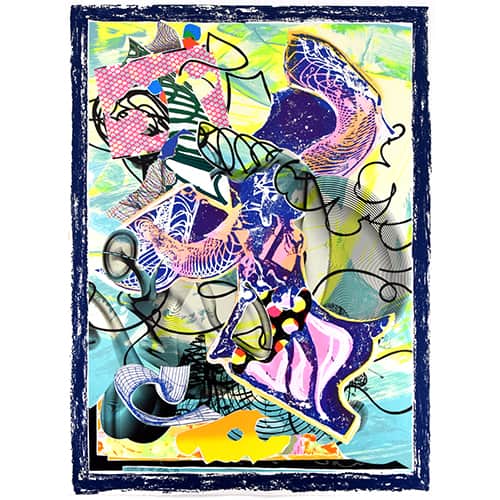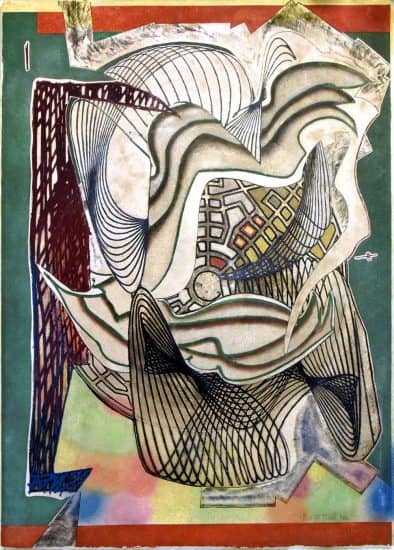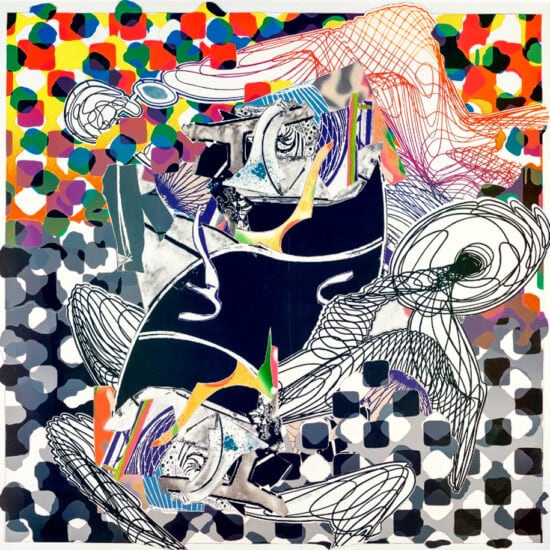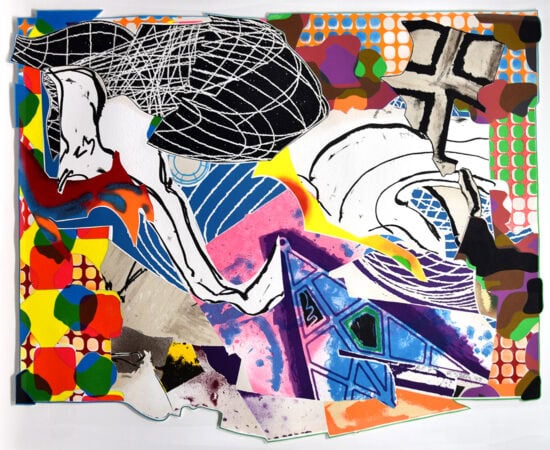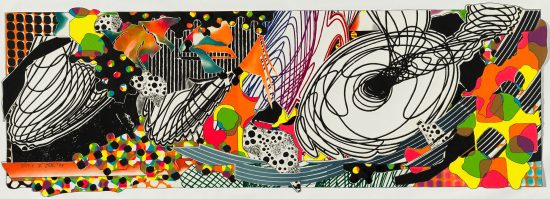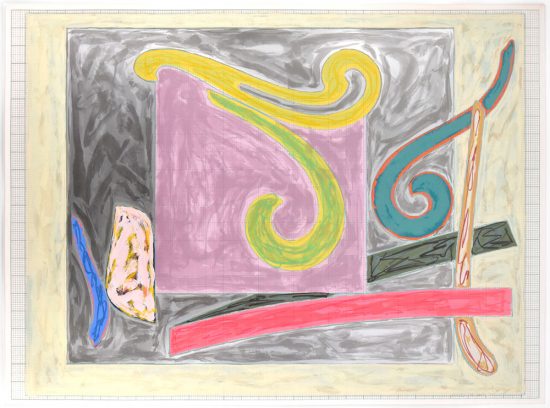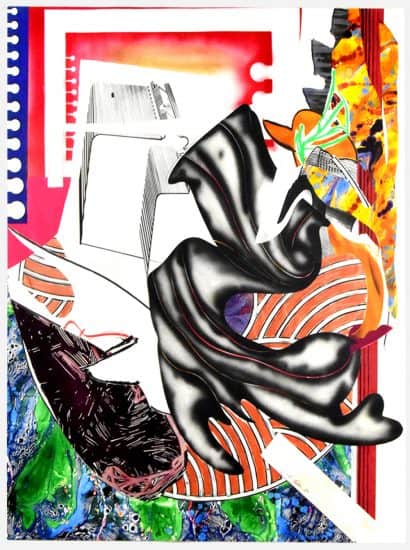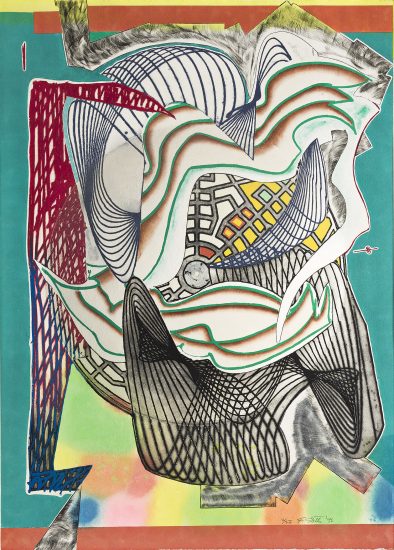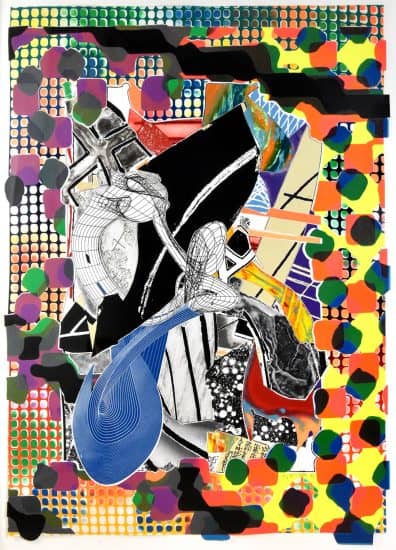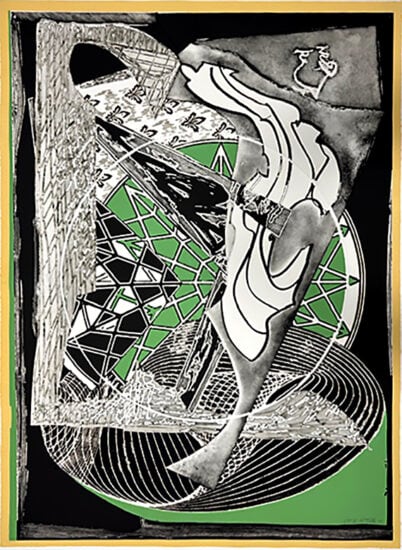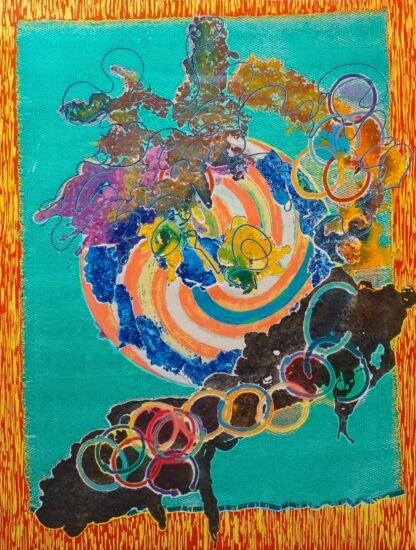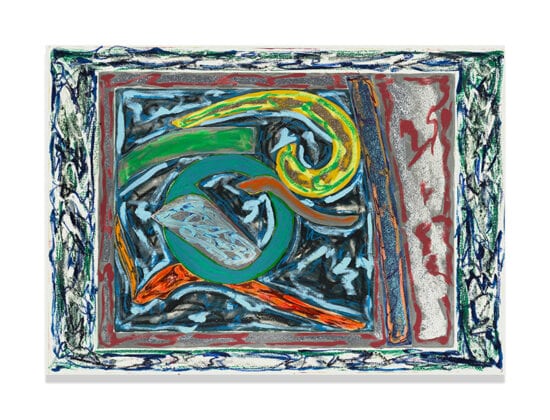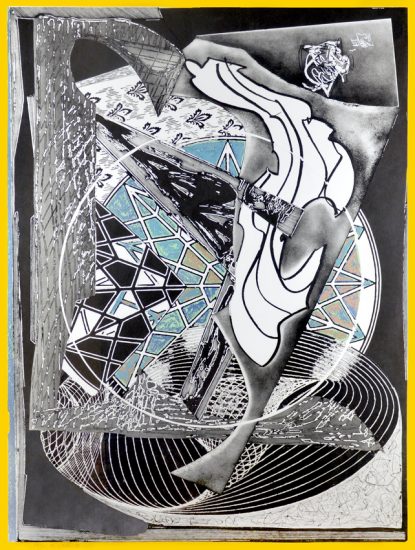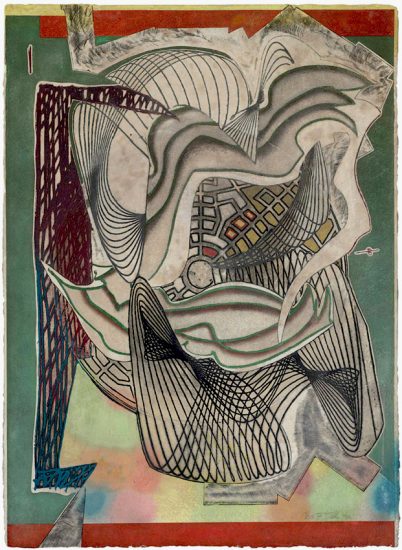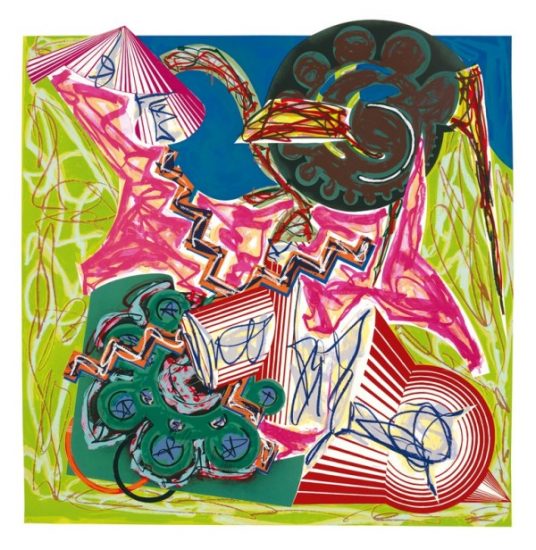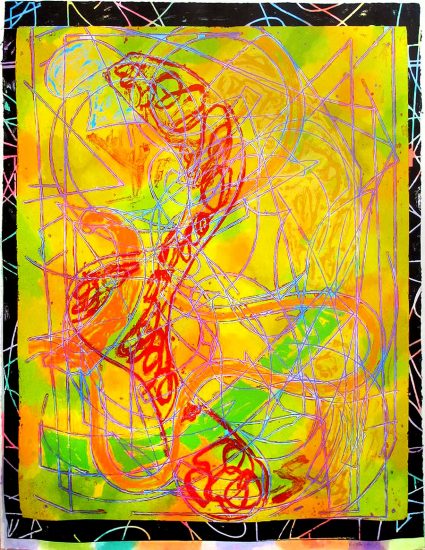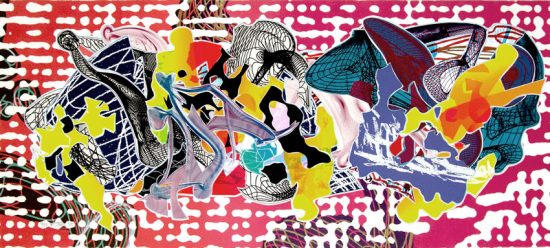Between the years 1985 and 1993, Frank Stella produced a vast number of works inspired by Herman Melville's Moby-Dick. The works are included within series such as The Waves, Moby-Dick Engravings, Moby-Dick Domes, and Moby-Dick Deckle Edges. Stella’s fascination with the novel spans various mediums, from collage and print to aluminum sculpture. In total, there are 138 artworks, each corresponding to a chapter within Moby-Dick. Upon first glance, it is clear that these works represent a departure from Stella’s earlier minimalist style. Often, geometric forms curve and swirl, layered in collage form. The colors are incredibly vibrant and add to the illusion of multiple dimensions.
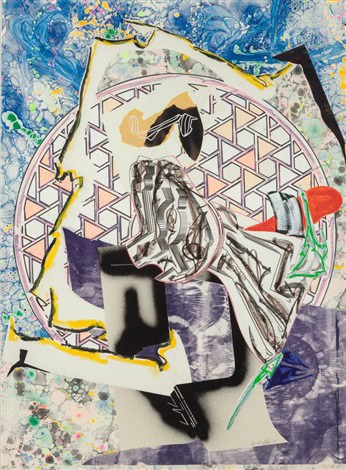
In order to understand Stella’s works, it is imperative to understand the significance of the Moby-Dick. Melville’s novel details a nautical journey led by Ahab, a one-legged ship captain.
Ahab’s main ambition is to kill Moby Dick, the whale who devoured his leg. As such, death, fate and ambition are central themes to the novel.
At once, it is possible to imagine the drama that unfolds in this journey. The drama within the novel played a great part in his vision for the Moby Dick works. In an interview, Stella explained “I think the Moby Dick series [1986-1997] is a kind of turning point. I was a little afraid, and probably still am a little, with Moby Dick, but the pictures [are] essentially curved surfaces. They started to really move, and the novel moves; you’re going around the world, it’s pretty wet, there are a lot of waves and motion (Pobric)." In this manner, Stella creates a visual narrative as powerful as its original textual form.
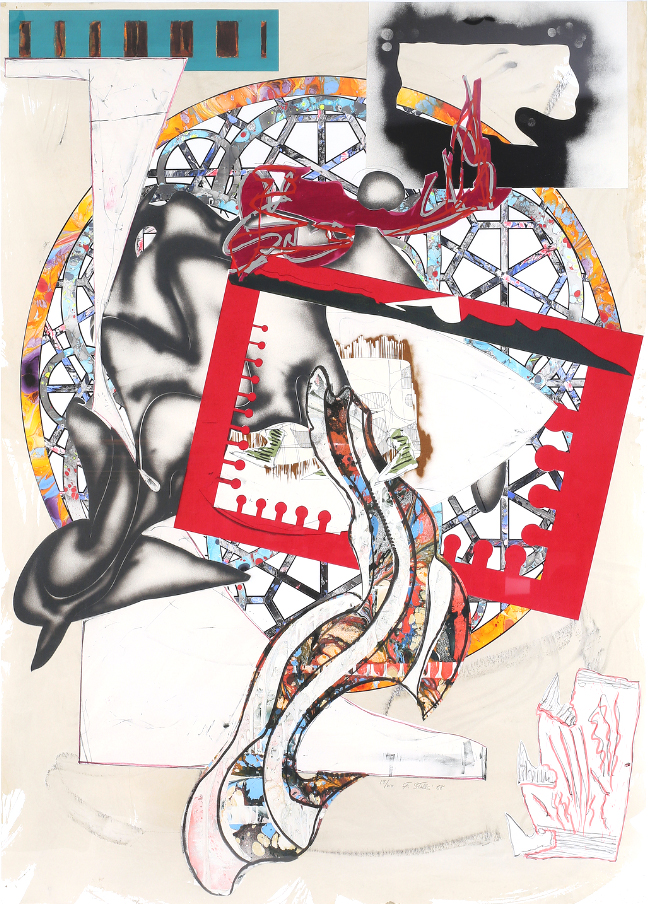
Rather than create literal depictions of the chapters, Stella astounds viewers by envisioning the soul of the novel. Each of the works derives its title from a chapter in Melville's classic novel. Stella captures the essence of the piece of narrative that each respective chapter describes using various printmaking techniques. With large swooping abstract forms, bold line and color, and a particularly masterful artistic hand, the artist creates an impressive number of works that evoke a grand sense of whimsy, drama, and intensity. The works are massive in size, which further expresses the drama and potence of the original text.
The Waves was begun simultaneously with the initiation of the first aluminum relief paintings in the Moby Dick series in 1985, the very first being Loomings 3X (completed 1986, Walker Art Center). The first of four prints series in the Moby Dick project, The Waves consists of thirteen screenprints with lithographic and linoleum block printings and with hand-coloring, marbling, and collage. The Waves incorporates all three major motifs of the Moby Dick project: the first appearance of the wave-whale shape, the most significant shape in the Moby Dick series as a whole; a variety of gutter shapes that the artist would develop during the history of the project; and the Chinese lattice shape. The key shape in The Waves is the centered lattice, both circular and rectangular, which anchors all other forms.
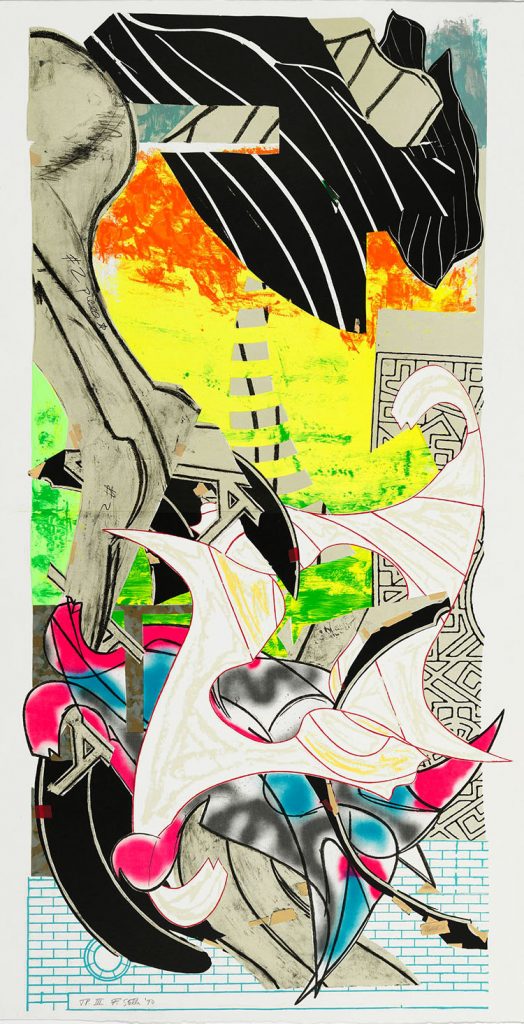
The Symphony, however, is a stand-alone print and not affiliated with any of the four Moby Dick print series. In this respect, it joins the contemporaneous The Candles (cat. 211) and The Fountain (cat. 212). A masterful combination of lithography and screenprinting, The Symphony references chapter 32 of Herman Melville's Moby-Dick. Although this chapter focuses on the harangues and mad ravings of Captain Ahab, it begins with a poetic description of a beautiful "clear steel-blue" day at sea, one in which the sky and sea were "hardly separable in that all-pervading azure." Despite the forceful shapes in Stella's the Symphony, there are a serenity and openness - in contrast to the dense agitations of the Moby Dick prints as a whole - that are not incompatible with the lyrical beginning of what becomes an essentially melancholic and discomforting chapter.
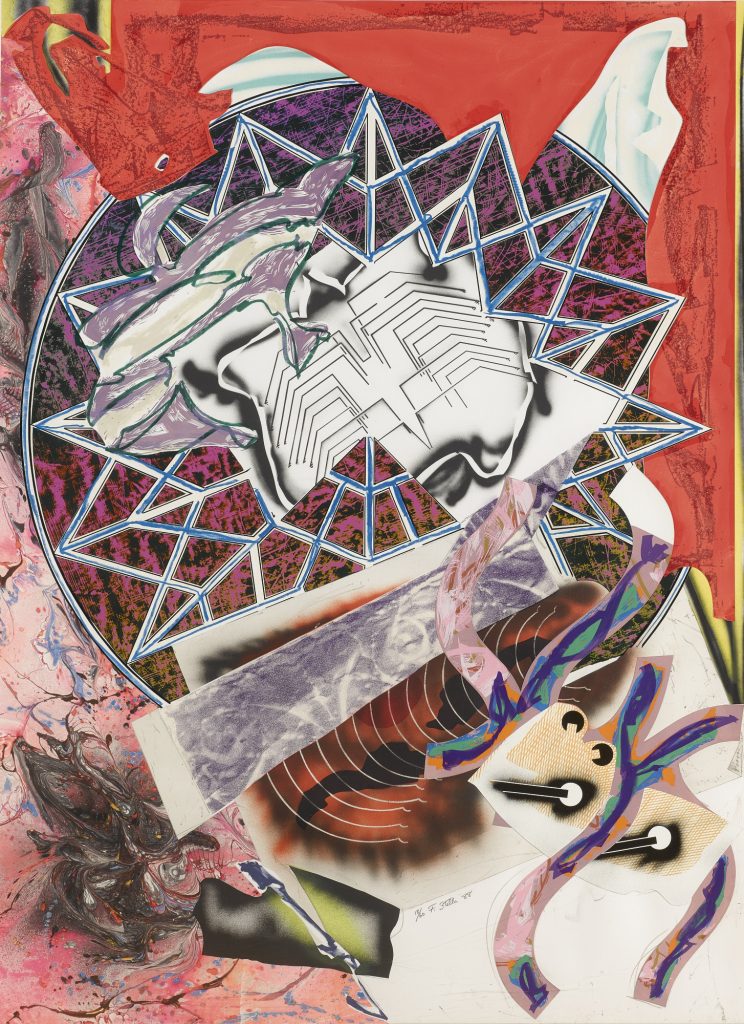
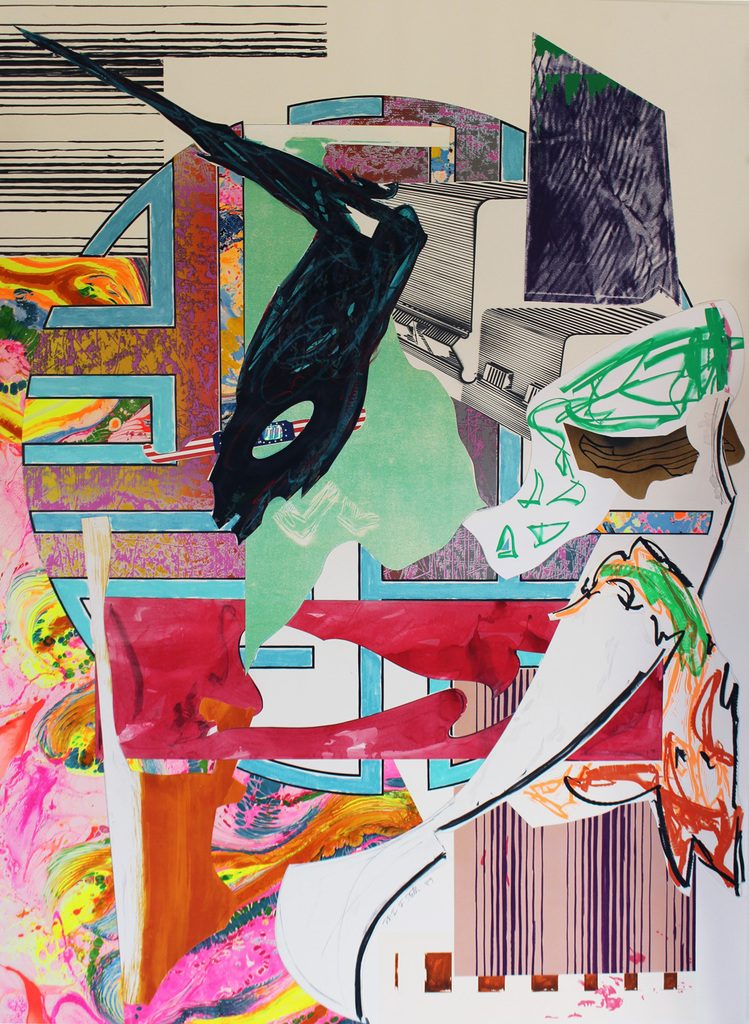
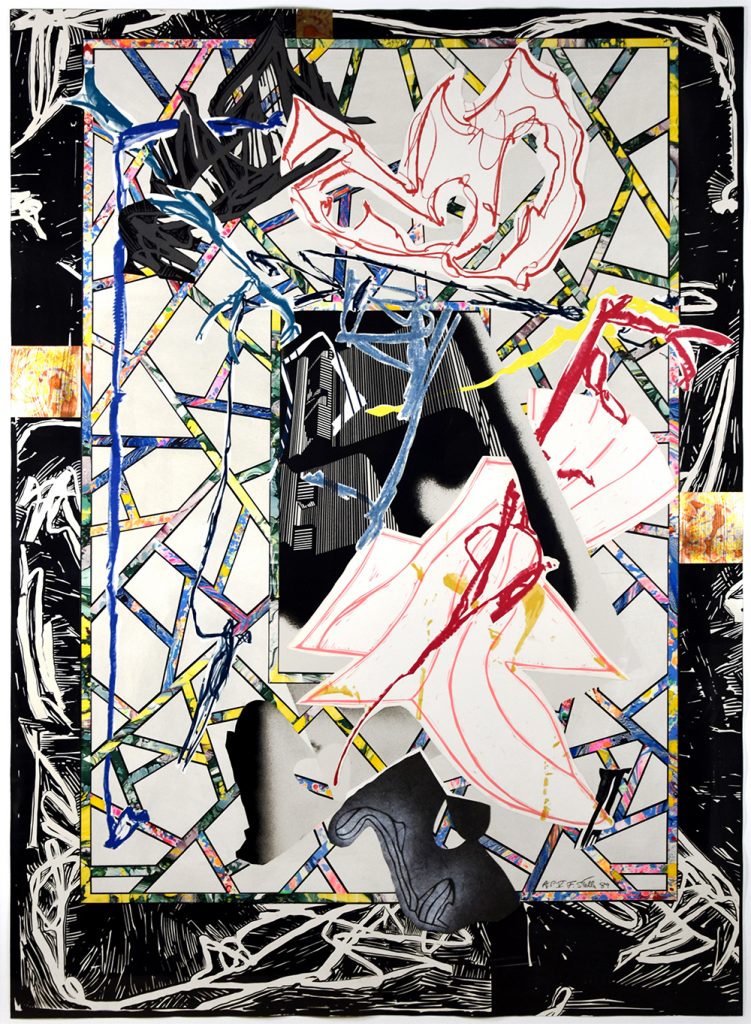
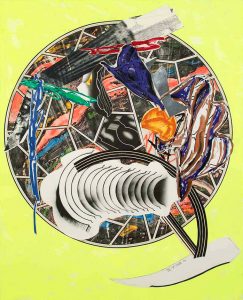
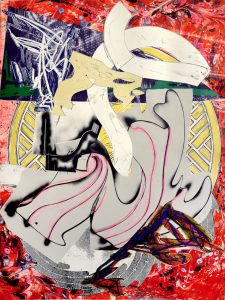
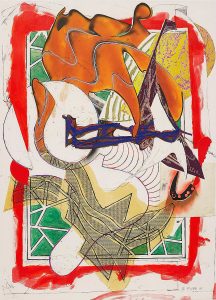
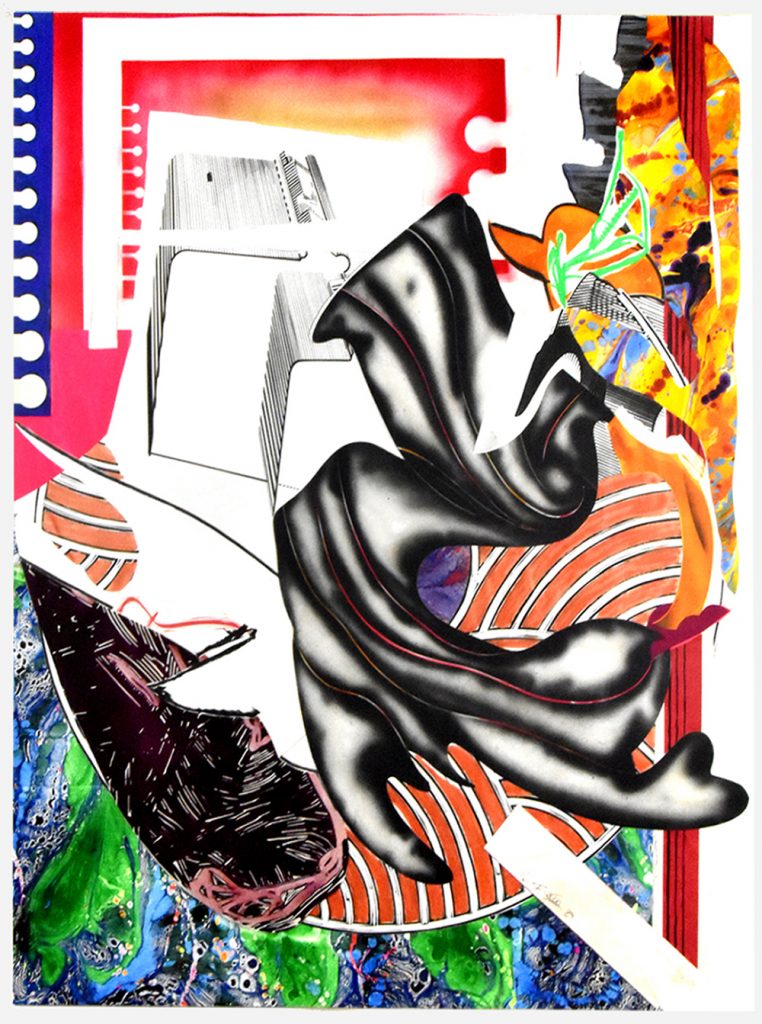
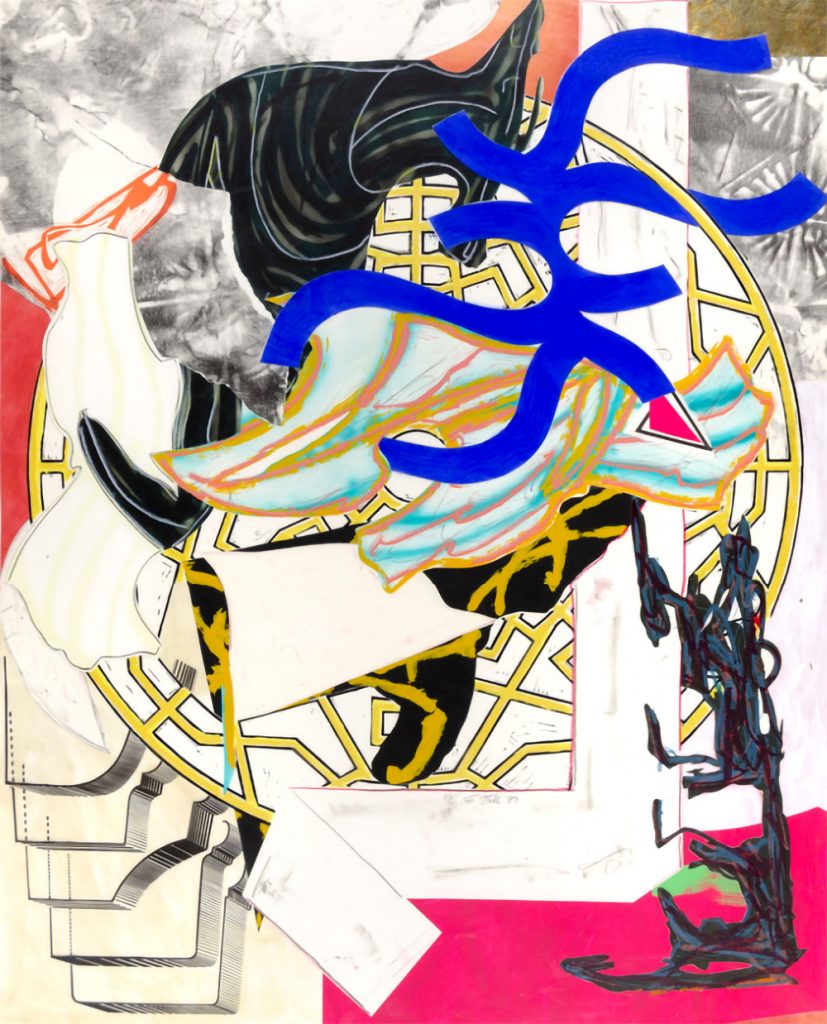
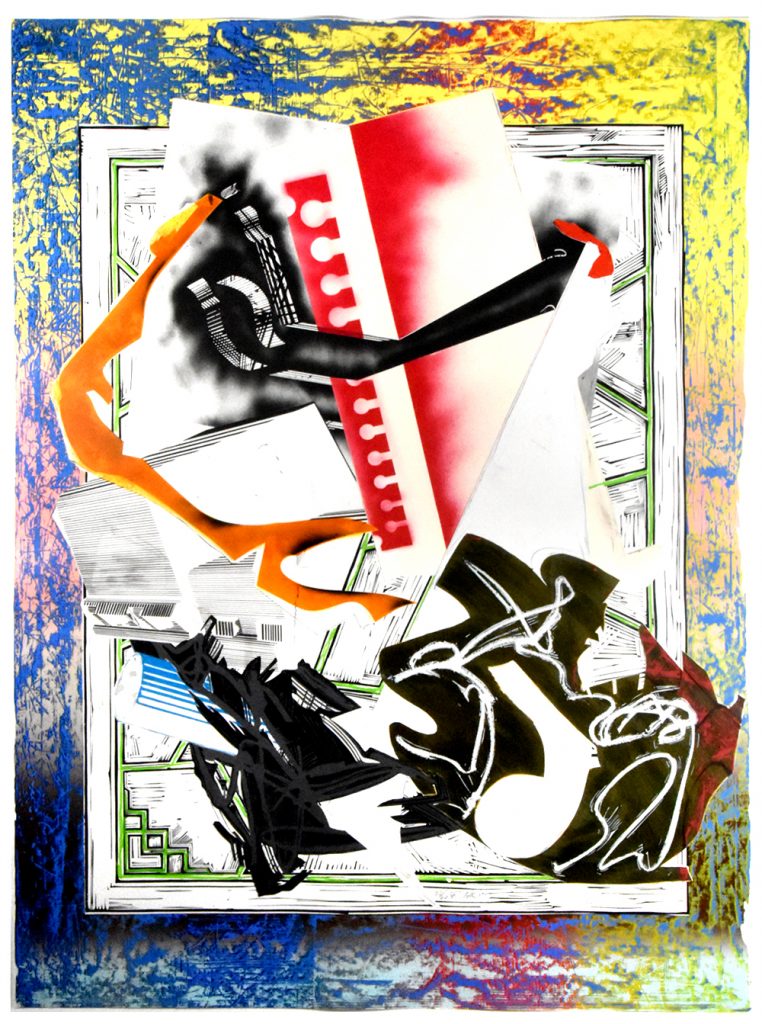
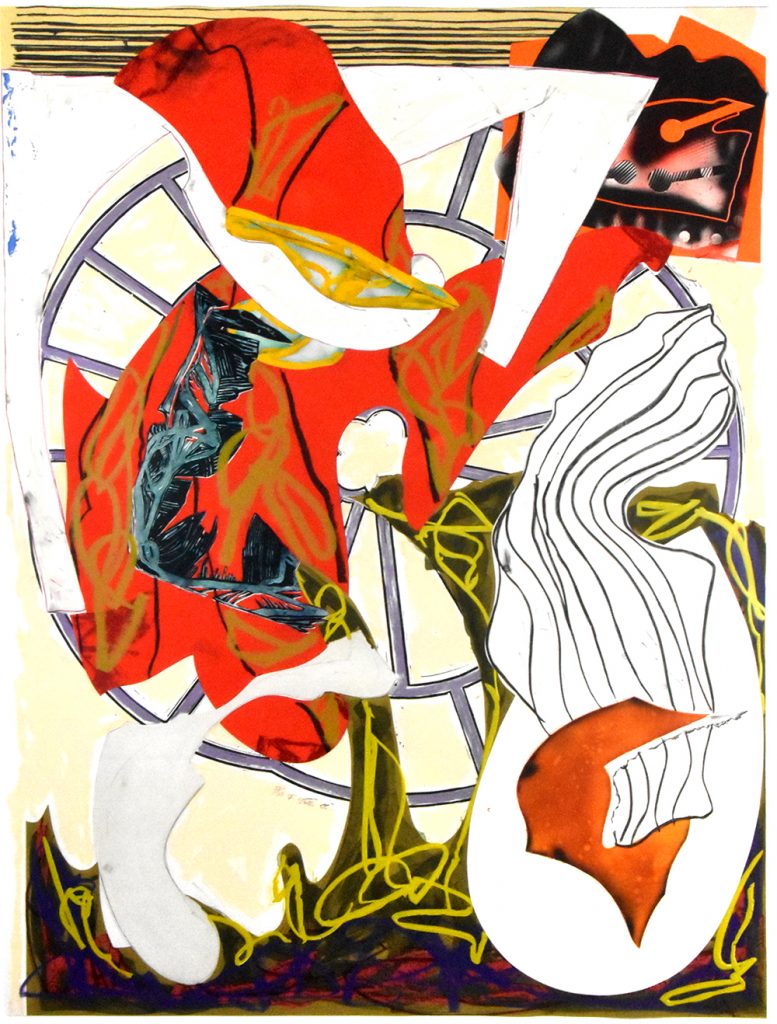
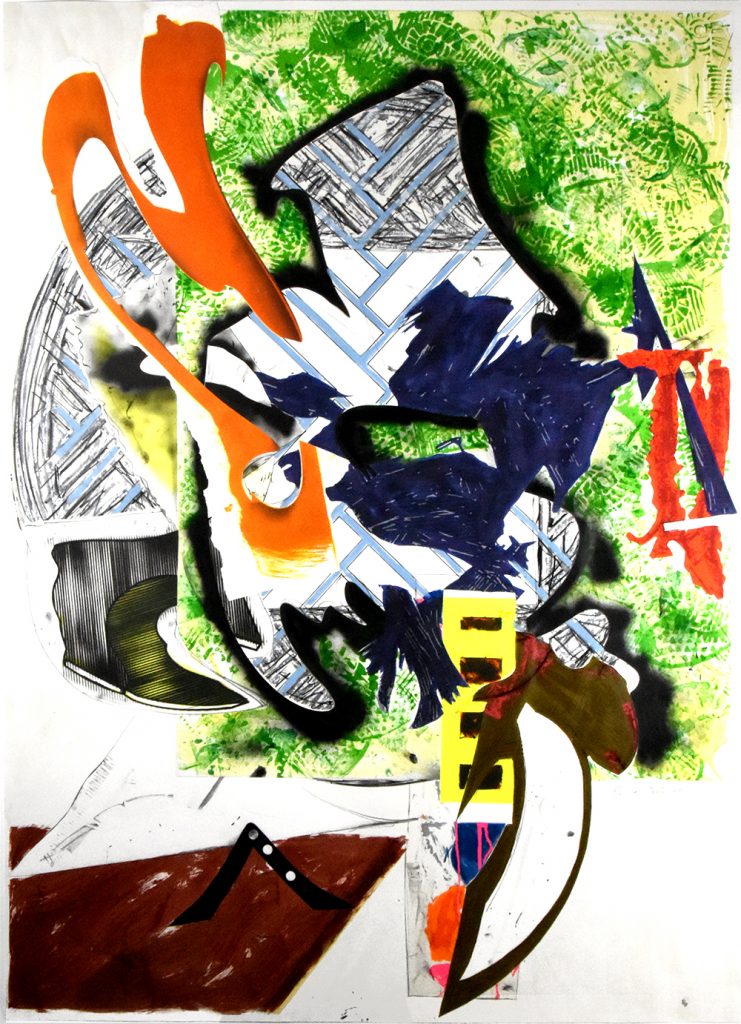
Between 1990 and 1993, Stella collaborated with Kenneth Tyler on three series and three individual prints linked to the Moby Dick project. The first published series was Moby Dick Engravings, a group of seven mixed-media prints variously combining etching, aquatint, relief, drypoint, Carborundum, and engraving printed on TGL handmade paper. The Dominant motif of Moby Dick Engravings is the wave-and-whale shape, which first appeared in The Waves prints. It plays and thrashes about in a sea of motifs from earlier metal-relief and print series, held momentarily in check by Chinese lattice fragment from The Waves and including skeletal outlines of the truncated pillars from Illustrations After El Lissitzky's Had Gadya and Italian Folktales, computer-distorted frigs and geometric volumes and newly invented forms. The mixed-media intaglio prints of the Moby Dick Engravings are solemn in their black-and-white tonalities enlivened with subtle washes of color. In abstract terms, Stella conveys a dramatic sense of roiling waters and breaching whales. The expressive gravity of this series is caught in the title Jonah Historically Regarded, a reference to chapter 83 of the novel. The Old Testament story of Jonah - who deserts God and is thrown overboard during a storm at sea and swallowed by a whale, but who lives to submit to God's will - is a central metaphor in Melville's grand narrative.
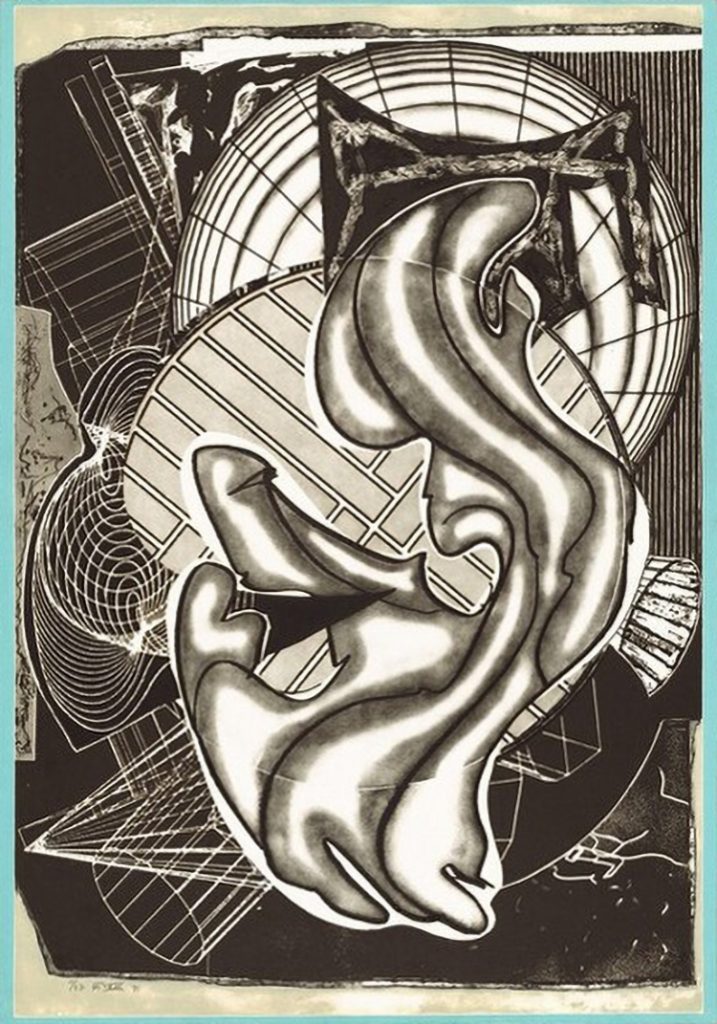

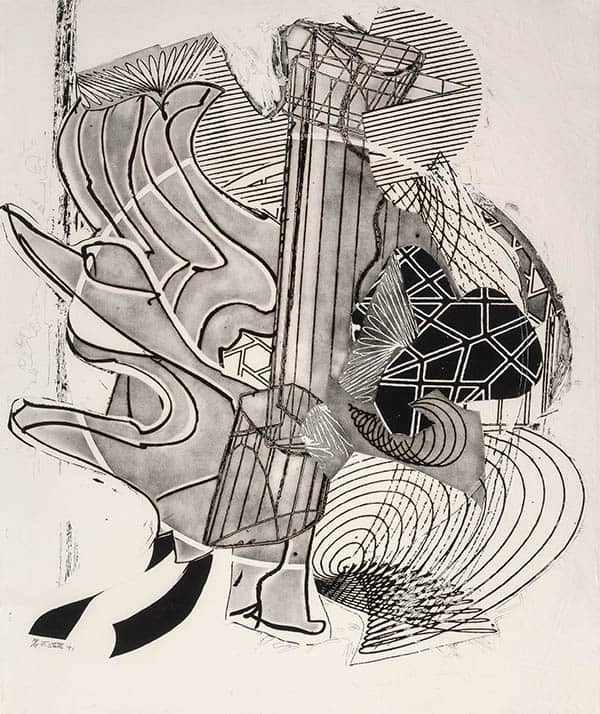
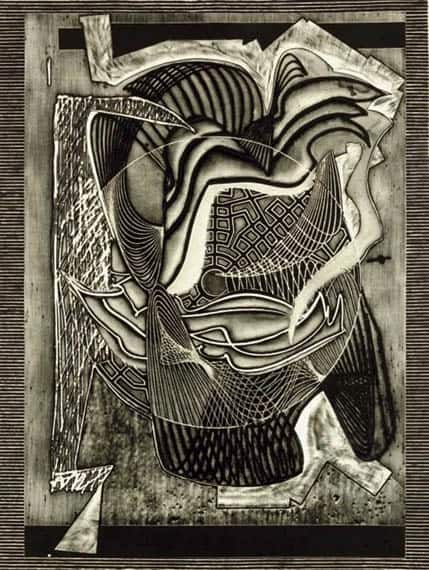
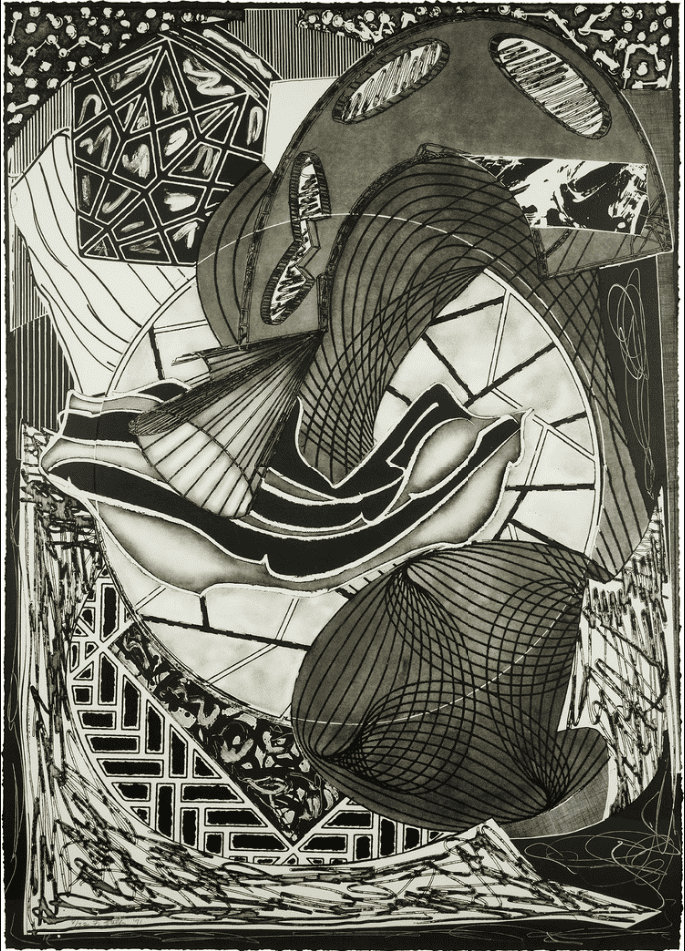
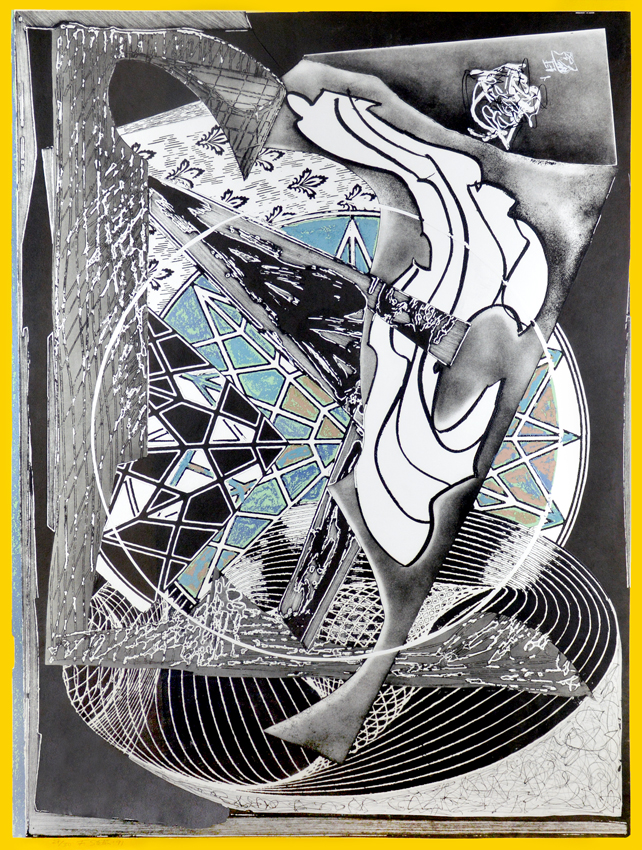
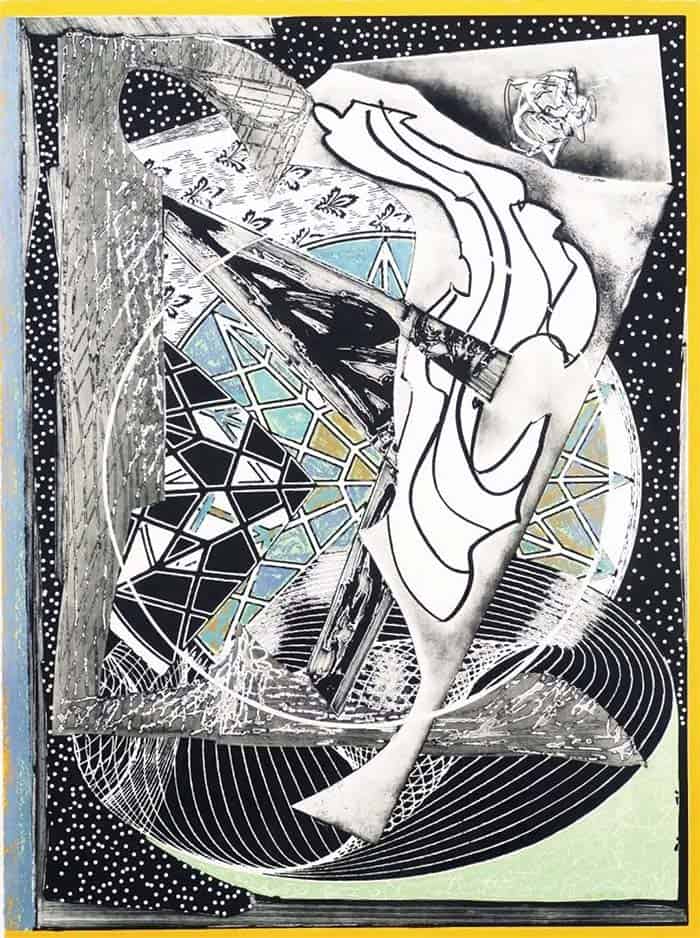
Stella took plates from each of the prints in Moby Dick Engravings and added engraving, screenprinting, and stencil. He then had them printed on multicolored stained paper with a three-dimensional element to create a kaleidoscopic and technical tour-de-force. Moby Dick Domes, whose plates were inked in vibrant colors, is dramatically different from the dark tonalities and stark dramas of Moby Dick Engravings. The two elements in Moby Dick Domes were a flat plate and a shaped dome plate fitted into a circular cutout. Both sections were fitted with an assembly of etched magnesium plates. Tyler adapted a hydraulic platen press to accommodate the domed shape. One great technical challenge was the tension of the shaped paper where it met the flat paper. Although handmade paper is basically waterleaf paper with with a great deal of flexibility, that is, without sizing. there is great stress put on the paper in the changing its shape from flat to dome.
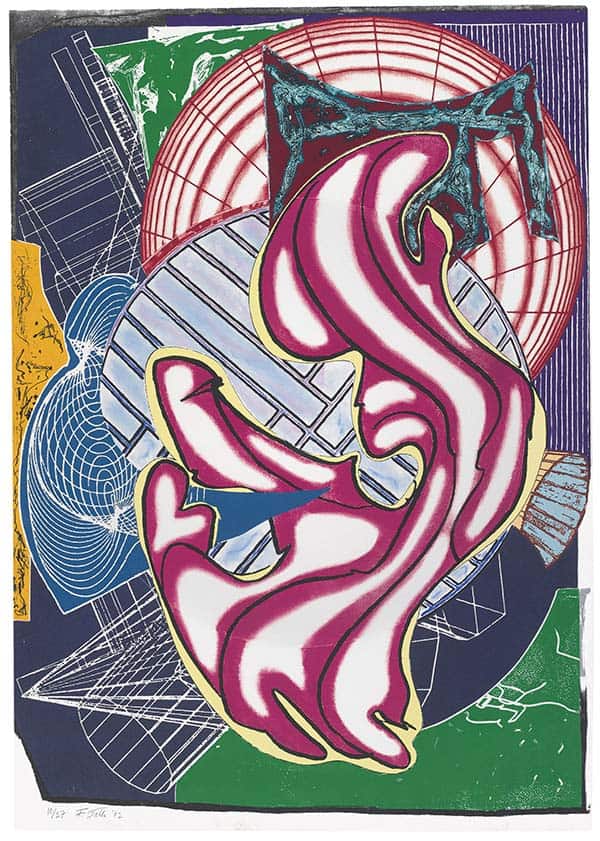
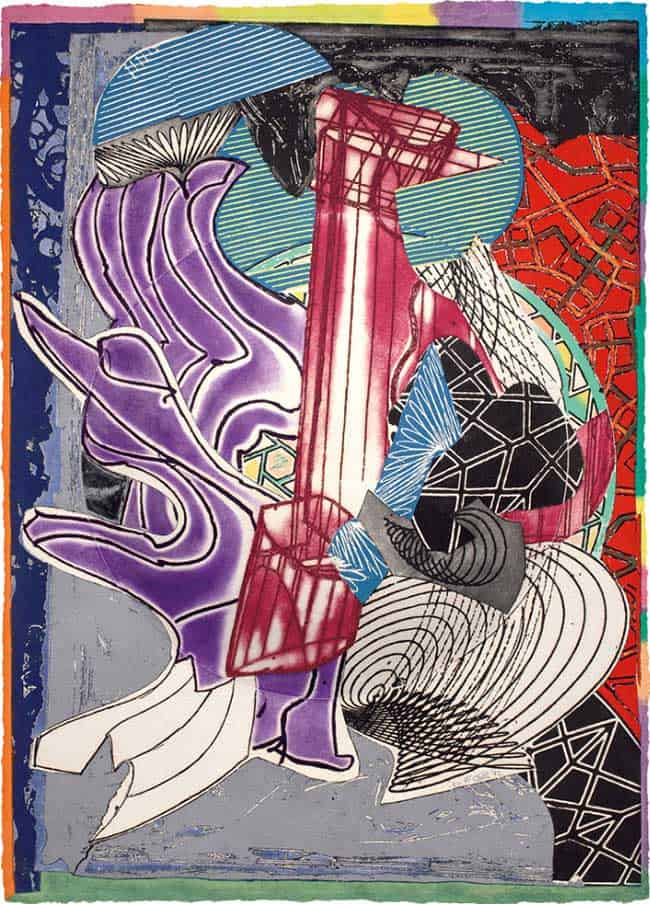
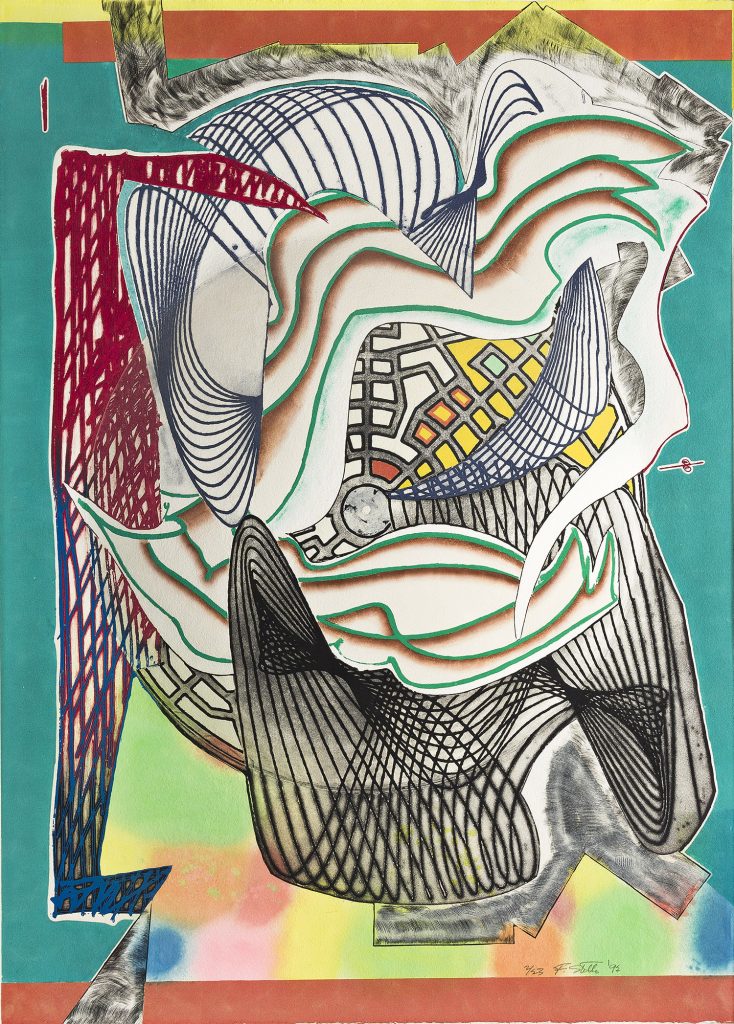
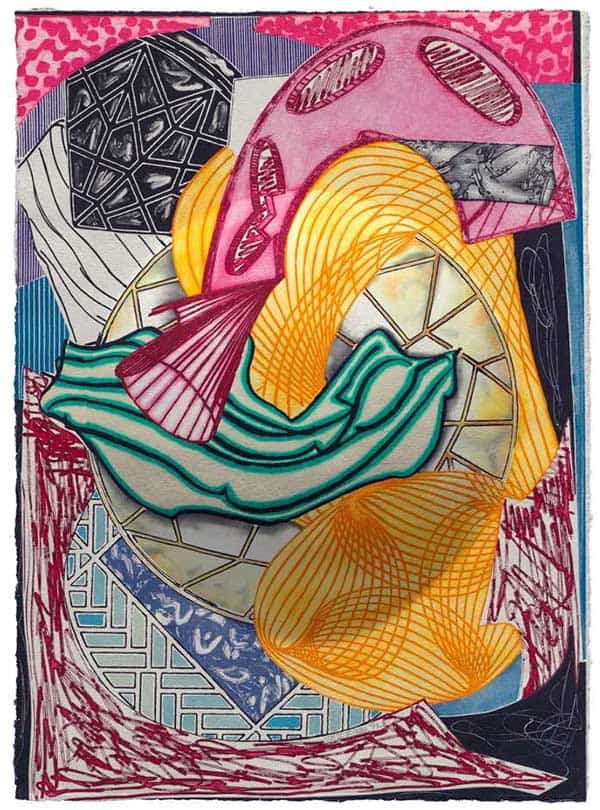
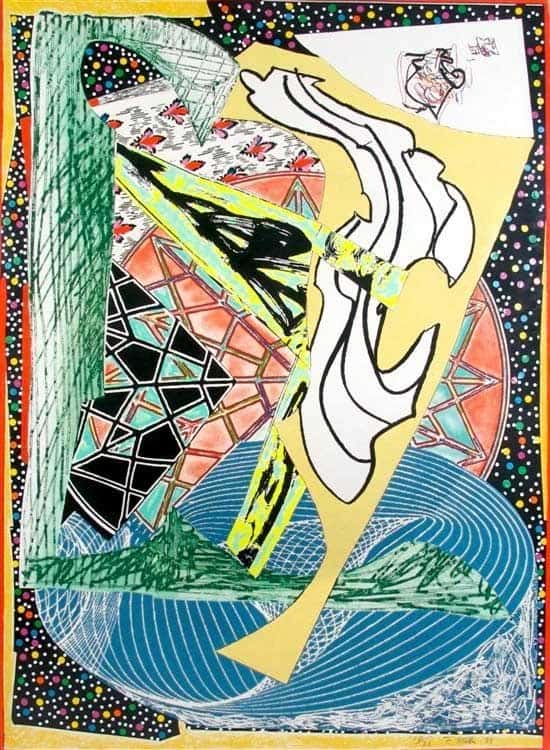
The Candles takes its name from chapter 119 in Herman Melville's Moby-Dick. It refers to the firey balls of lightning, also known as St. Elmo's fire, that illuminate the mast tops of Captain Ahab's whaling ship, the Pequod, during a thunderstorm. A sense of this dramatic phenomenon is caught in the radiant reds and oranges of Stella's The Candles, a lithograph with screenprinted and collaged elements. One of the most important new motifs not derived from previous work is the "smoke ring", first articulated in The Candles. Originating in photographs of Stella blowing cigar smoke, the smoke ring was then transformed through a series of computer and printed manipulations, providing the artists with proofs for print-directed collage templates, but also for works in other media, including relief paintings and wall constructions.
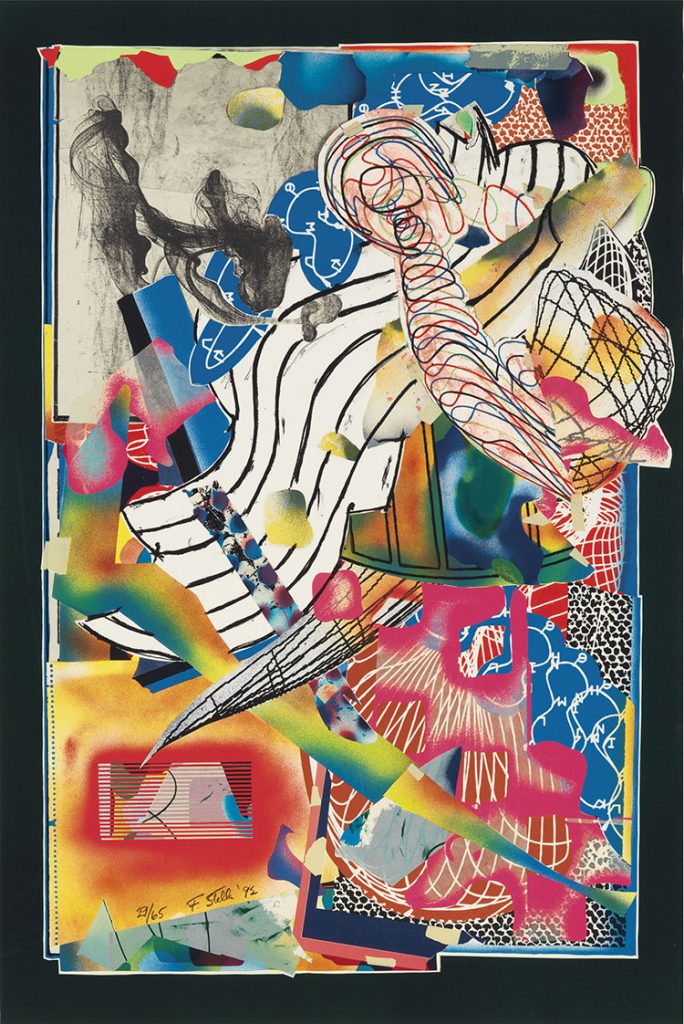
The Fountain is chapter 85 of Melville's Moby-Dick. The title refers to the spray expelled through the blowhole of the great sperm whale when it surfaces, having remained submerged for up to an hour (the composition of the spray is debated among scientists). The grandeur of the whale's size, which the chapter celebrates, is aptly translated in the scale of Stella's The Fountain. In a touch that is a literal reference to chapter 85, Stella incorporated a rainbow-like crescent in the upper left corner of the print, which alludes to Melville's description of the spewed mistiness from the whale's spout as "glorified by a rainbow".

As he had done in The Candles, and setting a precedent for a new working method, Stella began with a series of working collages from which the prints would proceed. The collages were built up with a variety of cutout printed material including snippets of earlier proofs, such as lattice and wave-wale motifs. Also added into the mix were patterns of enlarged color halftone dots, plastic construction frigs, and smoke rings - computer-generated from photographs. The imagery was further embellished with enlarged fragments of an engraved Canadian banknote, bits of text from a Japanese whale print, and glimpses of an early nineteenth-century Japanese woodcut by Utagawa Kuniyoshi titled Miyamoto Musashi and the Whale. In this series, Stella gives importance to white unprinted paper and to the tradition of the deckled edge, hence the title of the series. Stella plays with this tradition with shaped handmade and irregularly cut paper and overlapping edges - a subtle nod to Herman Melville's Moby-Dick in book form. In their dense compositions, flamboyant coloration, and churning energies, the prints of this series stand in dramatic contrast to the more open compositions and elegiac tone of the Moby Dick Engravings.
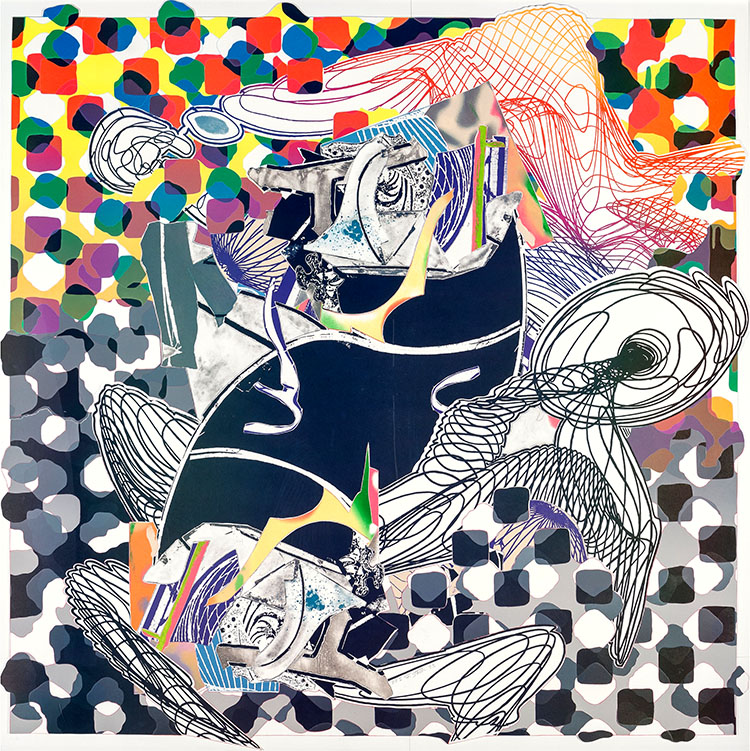
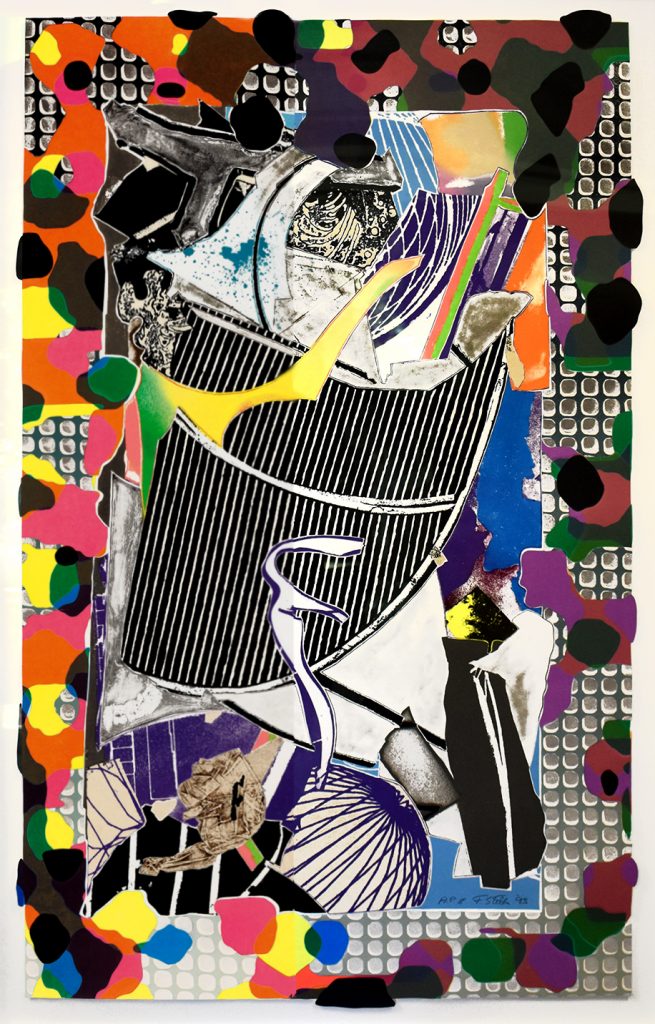
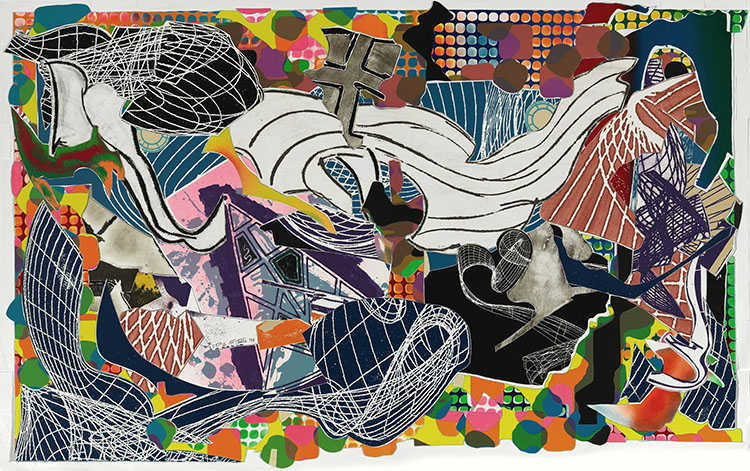
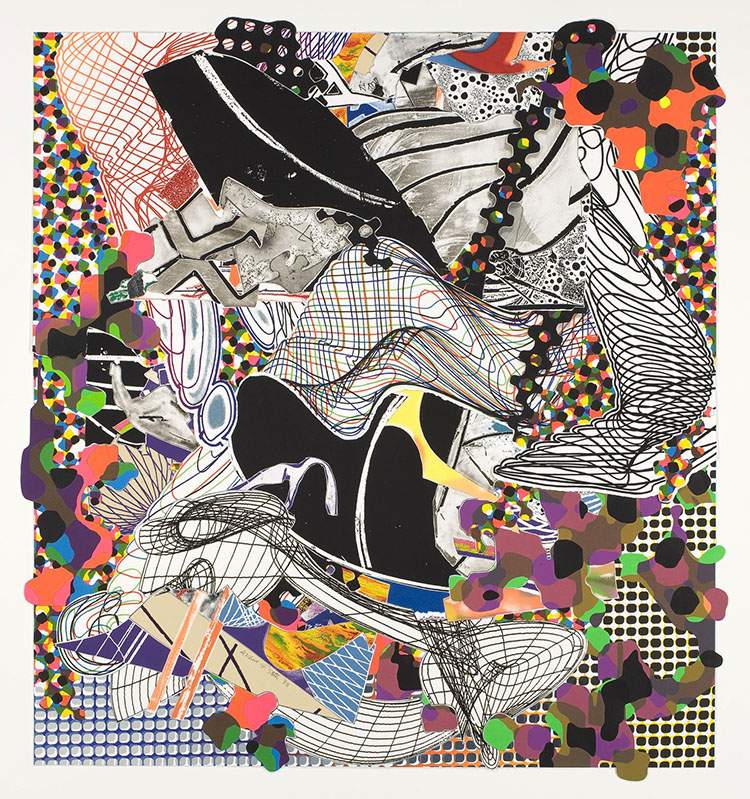
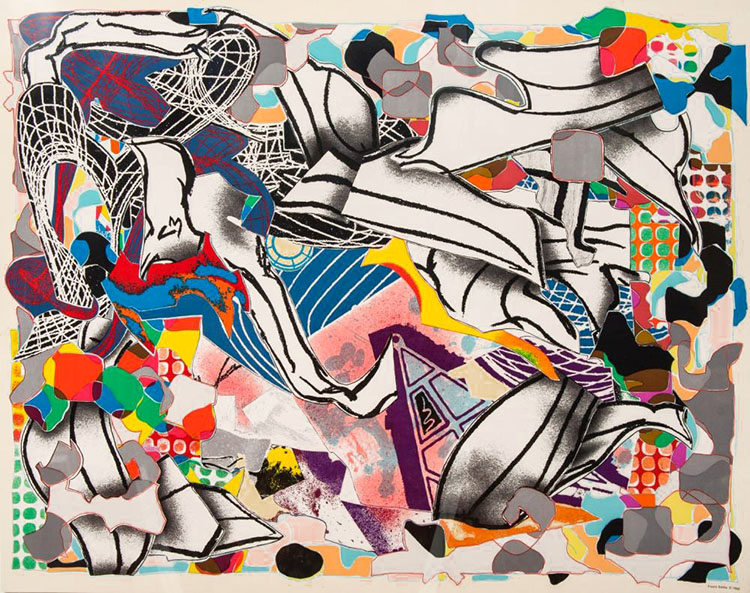
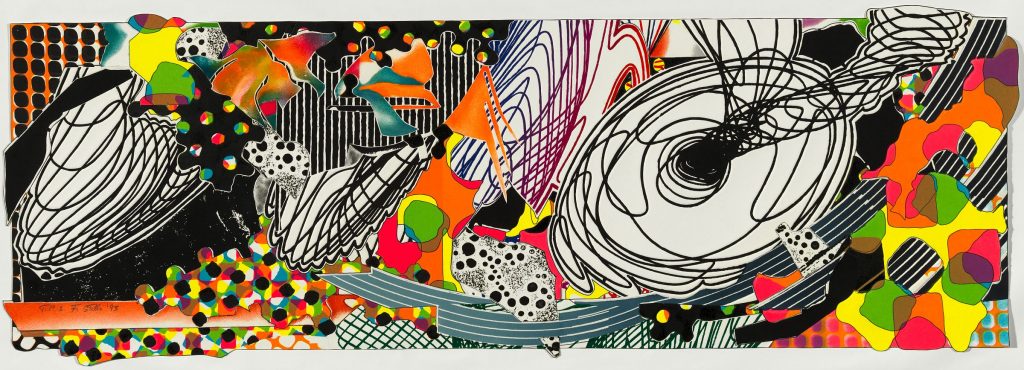
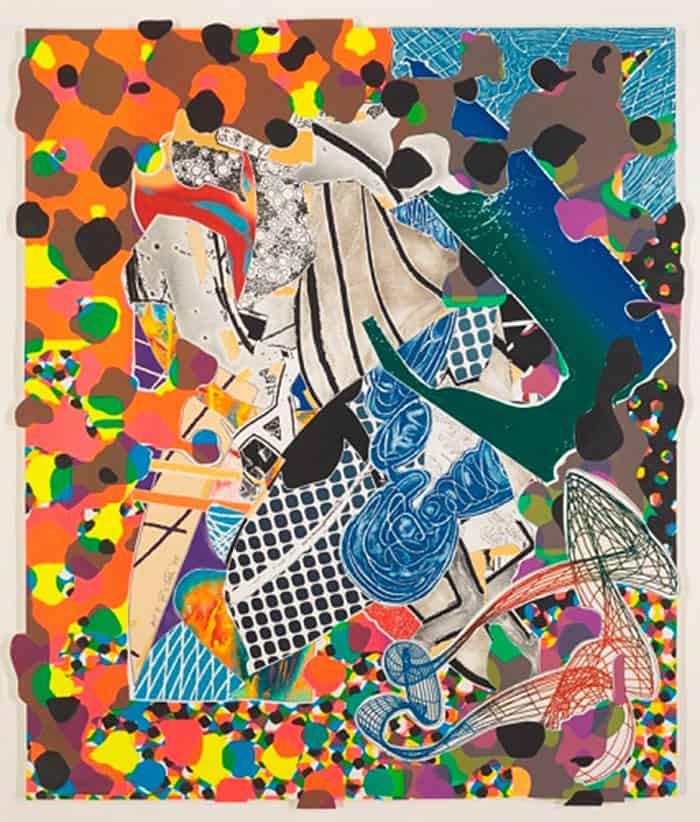
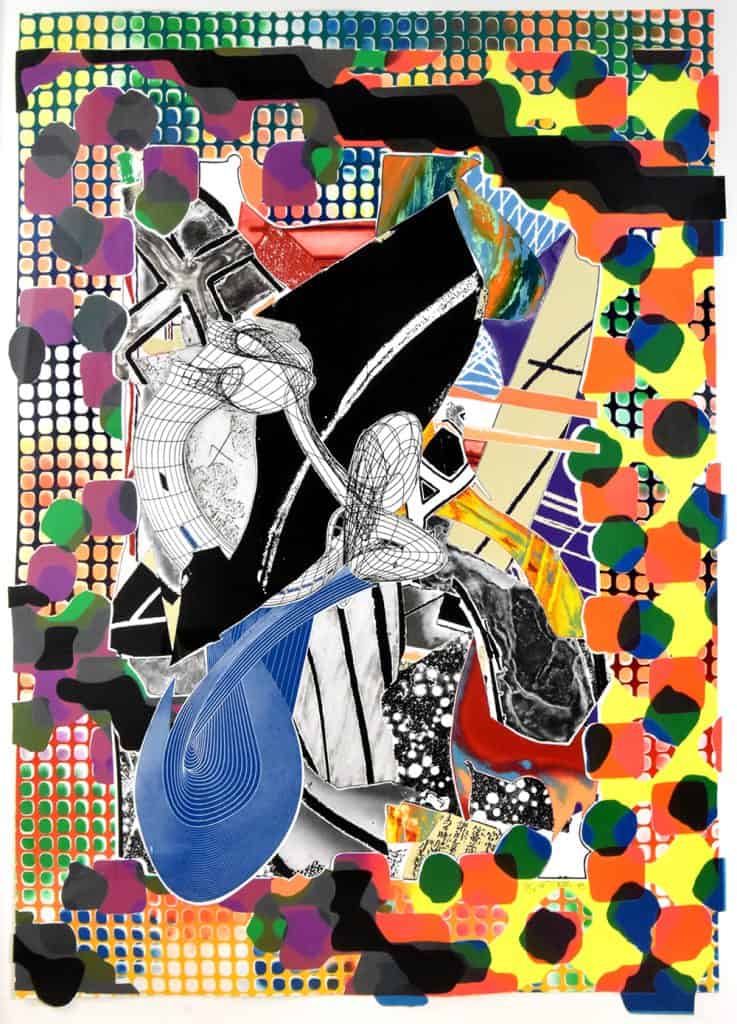
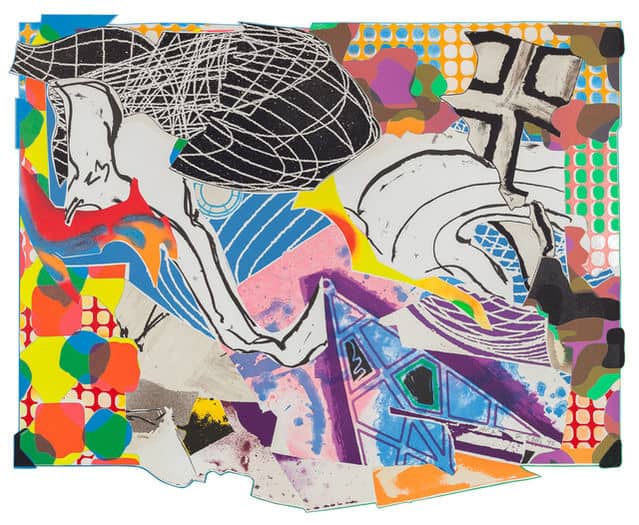

Please browse our fine art collection of Frank Stella prints.

